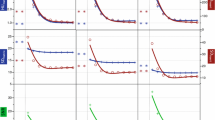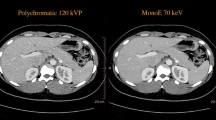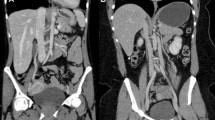Abstract
Objective
The purpose of study was to develop a computer-simulated liver phantom for hepatic CT studies. A computer-simulated liver phantom was mathematically constructed on a computer workstation.
Materials and methods
The computer-simulated phantom was calibrated using real CT images acquired by an actual four-detector CT. We added an inhomogeneous texture to the simulated liver by referring to CT images of chronically damaged human livers. The mean CT number of the simulated liver was 60 HU and we added numerous 5-to 10-mm structures with 60±10 HU/mm. To mimic liver tumors we added nodules measuring 8, 10, and 12 mm in diameter with CT numbers of 60±10, 60±15, and 60±20 HU. Five radiologists visually evaluated similarity of the texture of the computer-simulated liver phantom and a real human liver to confirm the appropriateness of the virtual liver images using a five-point scale.
Results
The total score was 44 in two radiologists, and 42, 41, and 39 in one radiologist each. They evaluated that the textures of virtual liver were comparable to those of human liver.
Conclusions
Our computer-simulated liver phantom is a promising tool for the evaluation of the image quality and diagnostic performance of hepatic CT imaging.











Similar content being viewed by others
References
Brix G, Lechel U, Veit R et al (2004) Assessment of a theoretical formalism for dose estimation in CT: an anthropomorphic phantom study. Eur Radiol 14:1275–1284
Begemann PG, van Stevendaal U, Manzke R et al (2005) Evaluation of spatial and temporal resolution for ECG-gated 16-row multidetector CT using a dynamic cardiac phantom. Eur Radiol 15:1015–1026
Gurung J, Khan MF, Maataoui A et al (2005) Multislice CT of the pelvis: dose reduction with regard to image quality using 16-row CT. Eur Radiol 15:1898–1905
Hyodoh H, Katagiri Y, Sakai T, Hyodoh K, Akiba H, Hareyama M (2005) Creation of individual ideally shaped stents using multi-slice CT: in vitro results from the semi-automatic virtual stent (SAVS) designer. Eur Radiol 15:1623–1628
Gupta AK, Nelson RC, Johnson GA et al (2003) Optimization of eight-element multi-detector row helical CT technology for evaluation of the abdomen. Radiology 227:739–745
Verdun FR, Denys A, Valley JF et al (2002) Detection of low-contrast objects: experimental comparison of single-and multi-detector row CT with a phantom. Radiology 223:426–431
Suess C, Kalender WA, Coman JM (1999) New low-contrast resolution phantoms for computed tomography. Med Phys 26:296–302
Muramatsu Y, Tsuda Y, Nakamura Y et al (2003) The development and use of a chest phantom for optimizing scanning techniques on a variety of low-dose helical computed tomography devices. J Comput Assist Tomogr 27:364–374
Kalender WA, Wolf H, Suess C et al (1999) Dose reduction in CT by on-line tube current control: principles and validation on phantoms and cadavers. Eur Radiol 9:323–328
Frush DP, Slack CC, Hollingsworth CL et al (2002) Computer-simulated radiation dose reduction for abdominal multidetector CT of pediatric patients. AJR Am J Roentgenol 179:1107–1113
Hu H (1999) Multi-slice helical CT: scan and reconstruction. Med Phys 26:5–18
Sabiston DC (1997) Textbook of urgery, 15 edn. Saunders, Philadelphia
Gies M, Kalender WA, Wolf H et al (1999) Dose reduction in CT by anatomically adapted tube current modulation. I. Simulation studies. Med Phys 26:2235–2247
Flohr TG, Schaller S, Stierstorfer K, Bruder H, Ohnesorge BM, Schoepf UJ (2005) Multi-detector row CT systems and image-reconstruction techniques. Radiology 235:756–773
Obuchowski NA (2003) Receiver operating characteristic curves and their use in radiology. Radiology 229:3–8
Partan G, Mayrhofer R, Urban M et al. W (2003) Diagnostic performance of liquid crystal and cathode-ray-tube monitors in brain computed tomography. Eur Radiol 13:2397–2401
Mayo JR, Kim KI, MacDonald SL et al (2004) Reduced radiation dose helical chest CT: effect on reader evaluation of structures and lung findings. Radiology 232:749–756
Kalra MK, Maher MM, Toth TL et al (2004) Strategies for CT radiation dose optimization. Radiology 230:619–628
Hamberg LM, Rhea JT, Hunter GJ et al (2003) Multi-detector row CT: radiation dose characteristics. Radiology 226:762–772
Nickoloff EL, Dutta AK, Lu ZF (2003) Influence of phantom diameter, kVp and scan mode upon computed tomography dose index. Med Phys 30:395–402
Sigal-Cinqualbre AB, Hennequin R, Abada HT et al (2004) Low-kilovoltage multi-detector row chest CT in adults: feasibility and effect on image quality and iodine dose. Radiology 231:169–174
Huda W, Scalzetti EM, Levin G (2000) Technique factors and image quality as functions of patient weight at abdominal CT. Radiology 217:430–435
Chabat F, Yang GZ, Hansell DM (2003) Obstructive lung diseases: texture classification for differentiation at CT. Radiology 228:871–877
Byng JW, Boyd NF, Fishell E, Jong RA, Yaffe MJ (1996) Automated analysis of mammographic densities. Phys Med Biol 41:909–923
Rikxoort EM (2004) Texture analysis. Internal report. Nijmegen Institute for Cognition and Information
Caldwell CB, Stappelton SJ, Holdsworth DW et al (1990) Characterization of mammographic parenchymal pattern by fractal dimension. Phys Med Biol 35:235–247
Author information
Authors and Affiliations
Corresponding author
Rights and permissions
About this article
Cite this article
Funama, Y., Awai, K., Miyazaki, O. et al. A computer-simulated liver phantom (virtual liver phantom) for multidetector computed tomography evaluation. Eur Radiol 16, 837–845 (2006). https://doi.org/10.1007/s00330-005-0012-5
Received:
Revised:
Accepted:
Published:
Issue Date:
DOI: https://doi.org/10.1007/s00330-005-0012-5




